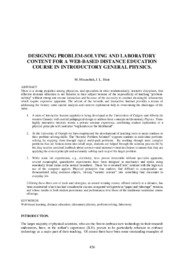| dc.contributor.author | Misanchuk, M. | en |
| dc.contributor.author | Hunt, J. L. | en |
| dc.coverage.spatial | CY - Λευκωσία | en |
| dc.creator | Misanchuk, M. | en |
| dc.creator | Hunt, J. L. | en |
| dc.date.accessioned | 2016-02-12T06:31:03Z | |
| dc.date.available | 2016-02-12T06:31:03Z | |
| dc.date.issued | 2005 | |
| dc.identifier.uri | http://hdl.handle.net/10797/14637 | en |
| dc.description | Περιέχει το πλήρες κείμενο | el |
| dc.description.abstract | There is a strong prejudice among physicists, and specialists in other mathematically intensive disciplines, that effective distance education is not feasible in their subject because of the impossibility of teaching “problem-solving” without strong one-on-one interaction and because of the necessity to conduct meaningful laboratories which require expensive apparatus. The advent of the versatile and interactive Internet provides a means of addressing the former; some careful analysis and creative exploration help in overcoming the challenges of the latter. 1. A suite of interactive lessons (applets) is being developed at the Universities of Calgary and Alberta (in western Canada) with careful pedagogical design to address basic concepts in Elementary Physics. These highly interactive tutorials mimic a private seminar experience, combining student exploration of a physical principle with instructor “explanation at the blackboard”. 2. At the University of Guelph we have emphasized the development of teaching tools to assist students in their problem-solving skills. The “Socratic Problem Solution” supports students in individual problem-solving by stepping them through typical multi-path problems. By working through more complex problems that are broken down into small steps, students are helped through the solution process bit by bit; they receive enriched feedback about correct—and incorrect—interim choices to ensure that they are applying the correct principle and accurately solving each step of the larger problem.
3. While some lab experiments, e.g., electricity, have proven intractable without specialist apparatus, several meaningful, quantitative experiments have been designed in mechanics and optics using essentially found items in the normal household. These “do-it-yourself labs” contrast with the high-tech use of the computer applets. Physical principles that students find difficult to conceptualize are demonstrated using common objects, turning “esoteric science” into something they encounter in everyday life. Utilizing these three sets of tools and strategies, an award-winning course, offered entirely at a distance, has been constructed which has had considerable success compared with previous “paper and videotape” versions and whose results in both student persistence and performance rival those of the traditional residential course offerings. | en |
| dc.language.iso | eng | en |
| dc.publisher | University of Zilina | en |
| dc.relation.ispartof | E- learning and distance learning | en |
| dc.rights | info:eu-repo/semantics/openAccess | en |
| dc.rights | Open Access | en |
| dc.source | CBLIS Conference Proceedings 2005 Integrating New Technologies in Science and Education | en |
| dc.title | Designing problem-solving and laboratory content for a web-based distance education course in introductory general physics | en |
| dc.type | info:eu-repo/semantics/conferenceObject | en |
| dc.subject.uncontrolledterm | Web-based learning | en |
| dc.subject.uncontrolledterm | Distance education | en |
| dc.subject.uncontrolledterm | Elementary physics | en |
| dc.subject.uncontrolledterm | Problem solving | en |
| dc.subject.uncontrolledterm | Laboratory | en |
| dc.contributor.conferenceorganizer | Learning in Science Group, University of Cyprus | en |
| dc.contributor.coordinator | Constantinou, Constantinos P. | en |
